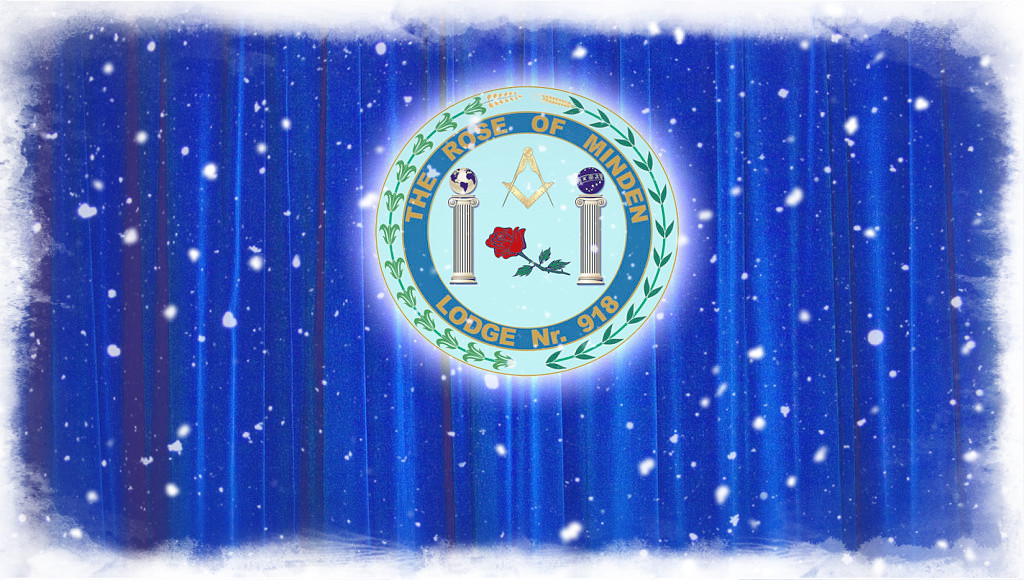The Rose of Minden Lodge
Number 918

History The Rose of Minden Lodge was originally established as a military Masonic organisation to provide a masonic home for members of the British Allied Forces in and around the German city of Minden, North Rhine-Westphalen. On 24 Jun 1972 it was discussed at a meeting of the Royal Electrical & Mechanical Engineers (REME) Officers Mess, Johansen Str 1, in Minden, the possibility of forming a Lodge in the Minden area. This was agreed and a petition was raised and passed to the Land Grand Master for review. It was agreed that a local Minden Lodge would be used for the regular meetings. It was also agreed that the founding Lodge Officers purchased their own regalia & collars and then subsequently present it as a gift to the Lodge for future officers to use. At a further meeting on 5 September 1972, which took place at Suffolk School, Elizabeth Barracks, Minden, it was decided the consecration would take place at 1100Hrs in the Temple of the local Herford German Lodge “Zur Roten Erde” Unter den Linden 34, on 28th October 1972 in the city of Herford. This location was chosen for the consecration meeting as the agreed new home for the Rose of Minden Lodge was at the time a small building consisting of just two rooms and renovations would not be completed in sufficient time for the founding ceremony. In 1990, once the cold war had finished, the 1990 Options for Change Strategic Defence Review (SDR) reduced the number of British Forces in Germany and withdrew out of Minden. As a result, the Lodge decided to move its seat from the city of Minden to an area where British Forces were still deployed in Germany and in turn returned to its founding ceremony location in Herford, which from 1993 also became the home of 1st UK Armoured Division. In 2010 under the UK’s SDR the deployment of British forces in Germany was announced to be ended by 2020 and the withdrawal of 20,000 service personnel started to take place. Late in 2019 it was announced that a small contingent would remain in Germany to act as a forward base in support of UK’s role within NATO. The personnel will remain located at the 45-square mile (117-square kilometer) Sennelager Training Area near Paderborn which provides extensive live firing and training facilities. Mönchengladbach will keep Ayrshire Barracks which can store approximately 2000 vehicles. The Wulfen Munitions Storage Facility will remain open for the storage of operational ammunition. Finally an Engineer unit equipped with M3, self-propelled amphibious bridging vehicles will remain colocated with German troops supporting the NATO infrastructure in Minden. The natural catchment area for new members for the Lodge was traditionally the military units which were stationed in the surrounding areas of Herford, Minden, Bad Oeynhausen & Bielefeld. This had a dramatic affect on membership with the changes announced in the 2010 SDR. However as British forces have been located in Germany for 75 years it naturally followed that a number of those decided to stay after their military service and according to the German Statistics Office “Destatis” the number of British ex-patriots (expats) living in North Rhine-Westphalen in 2017 was 25.125 . With Freemasonry in Germany growing steadily in numbers and becoming ever more popular since the second world war, it was noted that as well number the of expats joining, German and other European nationals were also applying for membership. This unusual & unexpected turn in events was found to be the increased interest in conducting masonic emulation & ceremonies in the English language rather than that of their own. This large number of expats and other nationals has enabled the Lodge and similar Lodges to survive the recent troop withdrawal. Freemason lodges typically choose titles in relation to their founding location, to a masonic theme or character. The Rose of Minden title was suggested by Brother B Potter and as such was used to publicise the founding of the Lodge to Freemasons in the surrounding area by an article in the local Minden Bulletin. The apt title is taken from the battle honour which was awarded to British Army units who fought in the Battle of Minden on 1 August reflecting its military connection at the time of its founding. The Battle Honour |
The Seal
The seal (pictured below) of the lodge is a combination of images relevant to its identity and masonic connections.
Bordering the seal are an ear of corn and a sprig of acacia, the ear of corn representing plenty and the sprig of acacia to represent Hiram Abiff, a central character within masonic history.
Within the border is the name of the lodge and its warranted lodge number. The abbreviation for word number is not written as No. as would be expected but as Nr. showing its German heritage.
Centrally placed are a red rose and the combined image of an architect’s square & compasses. The rose, as the lodge name suggests, represents the Rose of Minden and the square & compasses is the most recognisable symbol within freemasonry.
Two pillars are placed either side of the rose and square & compasses, these represent the two pillars placed outside of King Solomon’s temple, again, key objects within masonic history. Atop the pillars are two spheres showing terrestrial and celestial maps representing that freemasonry is seen by masons as being universal.
Ritual
The Rose of Minden Lodge conducts its “work/ ritual” in the English language and follows the English masonic constitution and traditions. However, our membership is very much international, naturally we have members from British backgrounds, but we also have a large contingent of German nationals and representatives from various other parts of the world we are proud to call Brothers.
The Lodge has associated orders of Mark Master Masons, Royal Ark Mariners and many more which can be found on the Progressive Orders page
Source: Wikipedia
 |

